Table of Contents
In the ever-evolving landscape of software management, the shift toward cloud-based Software as a Service (SaaS) is undeniable. Whether you like it or not, the world is moving to SaaS, and your role is evolving. As a Software Asset Manager, it’s time to recognize that traditional approaches might no longer suffice.
Will you sink or swim?
Here, we discuss the necessity of a SaaS Management program and why relying solely on legacy tools or spreadsheets could cost you millions.
Partial Visibility into SaaS = Partial Solution
In the past, SAM teams focused on managing a select few software vendors, prioritizing the most costly apps. They typically used spreadsheets or a legacy management program like Flexera or ServiceNow. That may have worked when each organization had only 15-20 on-premises apps, but SaaS has ushered in a new era of SAM.
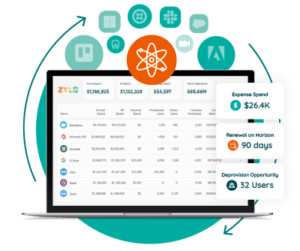 The modern approach demands a portfolio mindset encompassing visibility into all SaaS applications. SAM teams that lack complete visibility into their entire SaaS inventory will likely overlook potential security and compliance risks, overspend on software, and retain waste in unused licenses and redundancies.
The modern approach demands a portfolio mindset encompassing visibility into all SaaS applications. SAM teams that lack complete visibility into their entire SaaS inventory will likely overlook potential security and compliance risks, overspend on software, and retain waste in unused licenses and redundancies.
Security and Compliance Risks
One of the most pressing concerns stemming from lacking visibility is the heightened vulnerability to security breaches and compliance violations. Organizations can’t implement robust security measures or ensure compliance with regulatory requirements without a clear understanding of all their SaaS applications. Unmonitored applications may harbor vulnerabilities or fail to adhere to industry standards, exposing sensitive data to potential threats and regulatory scrutiny.
To put this into greater context, Gartner predicts organizations that fail to centrally manage SaaS life cycles will remain five times more susceptible to a cyber incident or data loss due to misconfiguration.
Resource Inefficiency
When organizations lack visibility into their SaaS stack, it often results in redundant software. What does this mean for your organization? Operational inefficiencies start to develop, where teams and employees operate in data silos. Your information may also start to silo, with teams and departments having limited access or none at all. Data may also be needlessly replicated due to this restricted access and disconnected software tools.
When individuals are purchasing SaaS, they may not be sourcing it from the best channel. Usually, it’s cheaper to get it directly from the vendor rather than a reseller or a Cloud marketplace. Add to that how companies usually get better rates for bulk purchases and you can see how you’re missing economies of scale on pricing when you have multiple contracts for the same tool.
Overspending and Financial Waste
Gartner research finds that organizations will likely overspend by 25% over the next few years. Employee-driven software purchases (shadow IT) are often the biggest culprit, resulting in uncontrolled costs and missed savings opportunities. By focusing exclusively on short-tail applications, organizations often overlook smaller SaaS purchases, which quickly add up. Not to mention, they’re often duplicate or redundant tools, limiting your purchasing power with vendors.
SAM teams without comprehensive insights into software usage patterns and license utilization can’t optimize procurement strategies or identify cost-saving opportunities. Full visibility lets organizations identify and address redundancies in their SaaS portfolio. By eliminating overlapping functions, you can eliminate unnecessary spending and improve your software stack.
Guide to Managing SaaS Costs
Learn MoreThe Imperative of Centralized Management
Centralized management with robust governance frameworks and technological controls helps protect organizations from Shadow IT and unmanaged SaaS. This approach ensures compliance with internal policies, industry regulations, and security standards, reducing risks from decentralized SaaS usage.
It also helps organizations tackle shadow IT challenges and strengthen their security posture. This includes comprehensive oversight, compliance enforcement, and quick responses to security threats.
Achieving complete visibility into every SaaS application may seem daunting, but not all applications warrant the same level of scrutiny. To address this challenge, SAM teams can use a tiered approach. Prioritizing oversight based on each application’s strategic significance and risk profile offers several benefits.
Strategic Resource Allocation
Amidst a surge in SaaS adoption, prioritizing short-tail applications comes at the expense of the software portfolio. While short-tail vendors get the most attention due to their perceived impact on overall spend, this narrow focus doesn’t account for other expenditures.
Tiered oversight lets SAM teams balance efficiency and effectiveness in software management. Rather than trying to manage every application with equal rigor, you can prioritize your efforts where they’ll have the greatest impact. This approach means that critical areas receive the attention they need without neglecting other applications.
Categorizing SaaS applications into tiers based on criticality, usage, and security impact means SAM teams can focus on high-priority applications while still overseeing less critical software assets.
Adaptive and Scalable Management
A tiered oversight framework lets SAM teams tailor their strategies to changing business needs and tech developments. As the SaaS landscape evolves, SAM teams can reallocate resources and adjust their focus, keeping their management practices aligned with organizational objectives.
This pragmatic approach lets organizations achieve comprehensive visibility and effective control over their software assets while maximizing resource efficiency and scalability.
Your Software Costs Will Continue to Spiral out of Control
The landscape of enterprise software expenditure is undergoing a significant transformation, marked by a pronounced shift toward SaaS solutions. Statistics underscore a concerning trend: enterprises are allocating increasingly substantial portions of their budgets to SaaS subscriptions and licenses. This upward trajectory in SaaS expenditure shows no signs of abating, with projections indicating further escalation in the coming years.
Software Asset Management teams that remain oblivious to a significant portion of their software landscape expose their organizations to greater costs. Enterprises already spend an exorbitant amount on SaaS – in fact, an average of $284M each year. Predictions by Gartner indicate a further 25% overspend on software in the coming years.
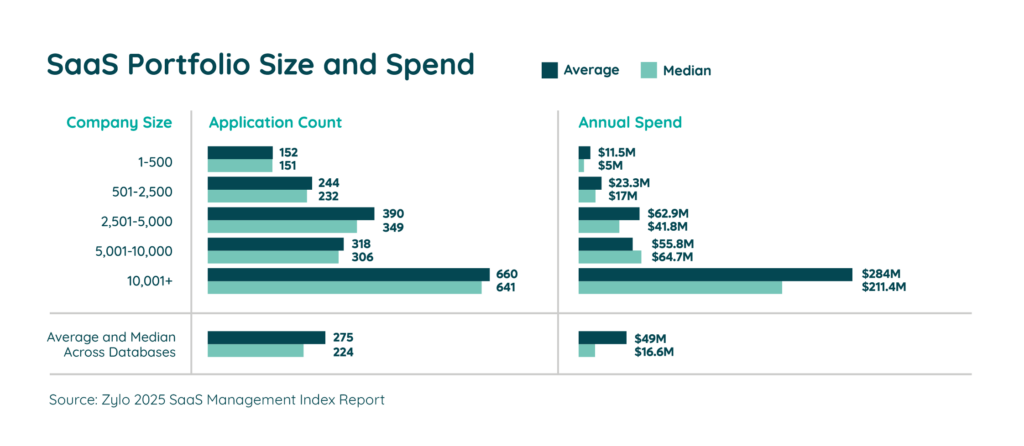
How can you buck the trend and reel in software costs before they become completely unmanageable?
Having full visibility helps SAM pros identify redundant software or duplicative contracts to recommend where rationalization can happen within the stack. Consolidating platforms and contracts can often help you get better pricing. That’s because the increase in licenses due to consolidation can often mean lower cost per user. Cutting apps altogether reduces OpEx and puts money back into the business.
Long-tail applications, those bought by business units and employees, are responsible for 74% of software spending, yet often slip under the radar. Achieving cost control at scale requires an approach that encompasses visibility, optimization, and strategic decision-making across the entire SaaS landscape.
Without visibility into all SaaS, unlocking cost control measures at scale is impossible. With insight into their SaaS ecosystem, organizations can negotiate more favorable terms and pricing structures with vendors.
Unknown and Unmanaged Risks Permeate Your Environment
SaaS ecosystems present distinct challenges and security concerns that demand a more agile risk reduction strategy. As part of this shift, organizations must evolve beyond simply maintaining audit preparedness. They must now pinpoint, evaluate, and address the risks pertinent to software utilization and secure data processing.
According to Gartner’s 2022 Market Guide for SaaS Management Platforms, organizations that fail to centrally manage SaaS life cycles remain five times more susceptible to cyber incidents. You can’t manage what you can’t see, which is why complete visibility is so important.
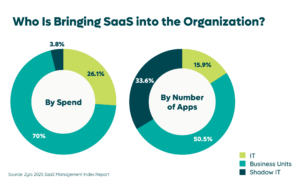
Take shadow IT, for instance. Shadow IT, or employee-led purchasing, comprises 33.6% of the average SaaS stack. Meanwhile, lines of business are responsible for 50.5% of software purchases. Without SaaS Management, eliminating security blind spots and ensuring compliance is much harder.
That’s because decentralized software purchases often bypass organizational oversight and procurement processes. Not only do they make up 84% of your stack, they’re also frequently mislabeled or miscategorized in expense reports, causing them to fly under the radar. The problem with this is that they haven’t passed muster with IT and Security.
Lack of visibility into these apps means your attack surface is greater, your security posture is weaker, and it’s more likely that applications do not comply with your internal policies and industry regulations. In the enterprise today, 68% of apps in large enterprises have “Poor” or “Low” risk scores, according to Netskope’s Cloud Confidence Index.
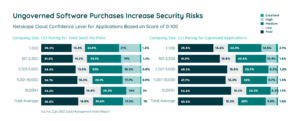
Decentralized purchasing and shadow IT risks leave an organization susceptible to cyber threats and breaches of regulatory standards. Without centralized governance and control, these unsanctioned applications can hinder IT security teams.
License Waste Runs Rampant, Costing You Millions
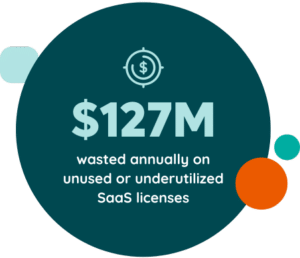 On average, enterprises use a mere 45% of their SaaS licenses, meaning 55% are unused (an 8% increase from 2023). That license waste equates to $127.3M annually! Without SaaS Management, identifying underutilized licenses and taking prompt action becomes a daunting task.
On average, enterprises use a mere 45% of their SaaS licenses, meaning 55% are unused (an 8% increase from 2023). That license waste equates to $127.3M annually! Without SaaS Management, identifying underutilized licenses and taking prompt action becomes a daunting task.
SaaS Management platforms (SMPs) are pivotal in addressing license waste by empowering organizations to make informed decisions. A platform provides visibility into the entire SaaS ecosystem, enabling you to accurately assess software usage patterns and identify instances of underutilized or redundant licenses.
Automation: The Key to Efficiently Trimming License Waste
Automation is a powerful tool that allows organizations to refine their processes and adapt quickly to evolving business needs. Now, businesses can adopt preemptive strategies like license reclamation, reallocation, or removal. This minimizes unnecessary expenditures and ensures better software investments.
It all starts with data. Integrations into a SaaS Management Platform will put that usage data front and center, with minimal effort. For example, Zylo supports various connection types like Direct Integrations and Usage Connect to support this.
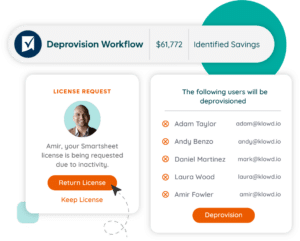 From there, a platform can surface optimization opportunities, like where you can reclaim unused licenses or downgrade users. Plus, what the cost avoidance and savings opportunity tied to it is. Once you prioritize what actions you want to take around license management, it’s easy to set automated workflows in motion. This type of automation is a formidable asset for optimizing your software spending.
From there, a platform can surface optimization opportunities, like where you can reclaim unused licenses or downgrade users. Plus, what the cost avoidance and savings opportunity tied to it is. Once you prioritize what actions you want to take around license management, it’s easy to set automated workflows in motion. This type of automation is a formidable asset for optimizing your software spending.
Embrace the Change or Face the Hard Truths
The trajectory of software management is tied to the rise of SaaS. Failing to adapt to this new paradigm could result in consequences ranging from financial losses to compromised security. Embracing a SaaS Management Platform is imperative for navigating the modern digital landscape. As a Software Asset Manager, the question isn’t whether to adopt an SMP – it’s how to do so effectively.
Ignoring SaaS Management isn’t just a risk—it’s a costly mistake. Embrace Zylo for Software Asset Managers to stay ahead in the SaaS era.

